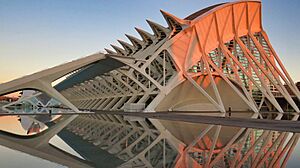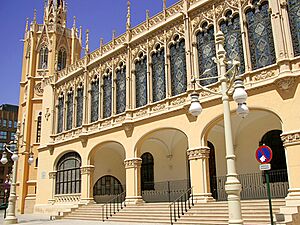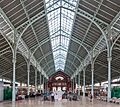History of Valencia facts for kids

The history of Valencia is very old, starting over 2100 years ago. It began as a Roman colony called "Valentia Edetanorum." This was built on the site of an older Iberian town, next to the Turia River. In 138 BC, a Roman leader named Decimus Junius Brutus Callaicus brought about 2,000 veteran soldiers to live in Valentia. The city was in a great spot near the sea, on a river island. A major Roman road, the Via Augusta, later crossed it.
In 75 BC, another Roman leader, Pompey, destroyed Valentia. But it was rebuilt about 50 years later with big new buildings. By the mid-1st century, the city was growing fast with many new people from Italy.
When the Roman Empire started to weaken, the church took over leadership in Valencia. In 625 AD, Visigoth soldiers were stationed there. Valencia was an important church city during this time. In 714 AD, the city gave up without a fight to Muslim invaders. Islamic culture then became strong. Valencia, known as Balansiyya, became a busy trading center from the 10th century onwards.
In 1092, a Castilian nobleman called El Cid led a mixed army of Christians and Muslims into Valencia. He conquered it in 1094 and ruled for five years. He died defending the city during a siege. Valencia stayed Christian until 1102, when the Almoravids took it back. In 1238, James I of Aragon attacked Valencia and made it surrender.
The city faced tough times in the mid-1300s. The Black Death in 1348 and many wars and riots caused a lot of damage. However, the 15th century was a time of great growth for Valencia. Culture and arts thrived in what is called the Valencian Golden Age. The first printing press in Spain was in Valencia. The city became one of the most important places on the Mediterranean Sea in the 15th and 16th centuries.
After the Americas were discovered, people from Valencia, like those from Catalonia and Aragon, were not allowed to trade across the Atlantic. This trade was controlled by Castile. This caused a big economic problem for Valencia. It got worse in 1609 when the Jews and the Moriscos (Muslims who had been forced to convert to Christianity) were expelled. The city declined even more after the War of Spanish Succession (1701–1714). This war ended the political freedom of the Kingdom of Valencia. The old laws of Valencia were removed, and the city was ruled by Castilian laws.
Valencia's economy started to get better in the 18th century. Silk weaving and ceramic tile making grew. The ideas of the Enlightenment in Europe also influenced the city's society and culture. The Peninsular War began when Napoleon's armies invaded Spain. When they reached Valencia, the people fought back on May 23, 1808. After a long siege, the French took the city on January 8, 1812. Valencia even became the capital of Spain for a short time when Joseph Bonaparte, Napoleon's brother, moved the royal court there in 1812. The French were defeated in 1813 and left Valencia in July.
After the war, Ferdinand VII became king. When he returned from France in 1814, he refused to follow the liberal Constitution of 1812, which limited his power. He went to Valencia instead of Madrid, abolished the constitution, and ruled as an absolute monarch for six years. The constitution was brought back for three years (1820–1823) during a liberal period. But conflicts continued, and a conservative rule followed, with harsh actions against liberals.
Later, Baldomero Espartero, a Prime Minister, declared that all Church property was national property. In Valencia, much of this was bought by wealthy citizens. The city was often in a state of change, with fights between liberals and republicans. The reign of Isabella II (1843–1868) brought more stability and growth. City services like water supply, paved roads, and gas lighting improved. A big project started at the port. Electricity arrived in 1882. In the late 1800s, landowners became rich from growing oranges and expanding vineyards. This economic growth also led to a revival of local traditions and the Valencian language. Around 1870, the Valencian Renaissance began, focusing on bringing back the Valencian language and culture.
Contents
Valencia in the 20th Century
In the 20th century, Valencia remained the third largest city in Spain. Its population tripled, from about 213,000 people in 1900 to over 739,000 in 2000. Valencia was also third in industrial and economic growth. The city expanded in the late 1800s. The Banco de Valencia was created in 1900. New markets and the Gare du Nord railway station were built. By the early 1900s, Valencia was an industrial city. While many small businesses existed, larger companies started forming as machines became more common. Workers began to organize and demand better living conditions. The Republican party, led by Vicente Blasco Ibáñez, supported these demands and became very popular.
World War I (1914–1918) hurt Valencia's economy, especially its orange exports. A dictatorship under Primo de Rivera (1923–1930) calmed social unrest for a few years. But workers continued to become more politically active. The Second Spanish Republic (1931–1939) allowed more people to take part in politics. This led to more political activity, especially after conservative groups gained power in 1933. The 1936 elections were won by the Popular Front, a group that supported the interests of ordinary people.
On November 6, 1936, Valencia became the capital of Republican Spain during the Spanish Civil War. The city was heavily bombed by air and sea, causing a lot of damage. By the end of the war, Valencia had survived 442 bombings. Valencia surrendered on March 30, 1939, and Nationalist troops entered the city.
The years after the war were hard for Valencians. Under Francisco Franco's rule, speaking and teaching the Valencian language were forbidden. Today, learning Valencian is required for every schoolchild in Valencia. The economy started to recover in the early 1960s. The city grew very quickly as many people moved there for new jobs and city improvements.
With Spain's return to democracy, the old kingdom of Valencia became a new autonomous region called the Valencian Community. Valencia was named its capital in 1982. Since then, Valencia has seen a big growth in its culture. New cultural places like the City of Arts and Sciences have opened. Public works and the restoration of the Old City have made Valencia a better place to live. Tourism has also steadily increased. Valencia hosted the America's Cup yacht race in 2007 and again in 2010.
Valencia in the 21st Century
In July 2006, Valencia hosted the World Day of Families. During a special Mass at Valencia's Cathedral, Pope Benedict XVI used the Santo Caliz, a cup that some Catholics believe is the Holy Grail. This simple stone cup is believed to have been brought to the church in the 3rd century.
Valencia was chosen in 2003 to host the famous America's Cup yacht race. It was the first European city to do so. The races took place from April to July 2007. On July 3, 2007, the team Alinghi won the America's Cup. Valencia was chosen again to host the 33rd America's Cup in February 2010.
From 1991 to 2015, the City Council was led by the People's Party and Mayor Rita Barberá Nolla. In 2015, a new group called Coalició Compromís won the election, and Joan Ribó became the new mayor.
Population Growth in Valencia
Here's how Valencia's population has changed over time:
| Date | Population | |
|---|---|---|
| 1360 | 30,000 |
|
| 15th century | 70,000 |
|
Images for kids
-
The Towers of Serranos are one of the old gates that guarded Valencia's Christian city walls. They were built between 1392 and 1398.
-
El Micalet or El Miguelete is the bell tower of the cathedral.
-
The Pennon of the Conquest, the flag raised by the Moors of Valencia in 1238 to show their surrender to King James I of Aragon.
-
Tirant lo Blanch, a famous knightly story written by the Valencian knight Joanot Martorell.
-
The Meeting of the Brotherhoods (La paz de las Germanías), a painting by Marcelino de Unceta.
-
"The Cry of El Palleter", an oil painting by Joaquín Sorolla.
-
The triumphant welcome of Ferdinand VII of Spain in Valencia, 1814, by Miquel Parra.
See also
 In Spanish: Historia de la ciudad de Valencia para niños
In Spanish: Historia de la ciudad de Valencia para niños
- Timeline of Valencia














